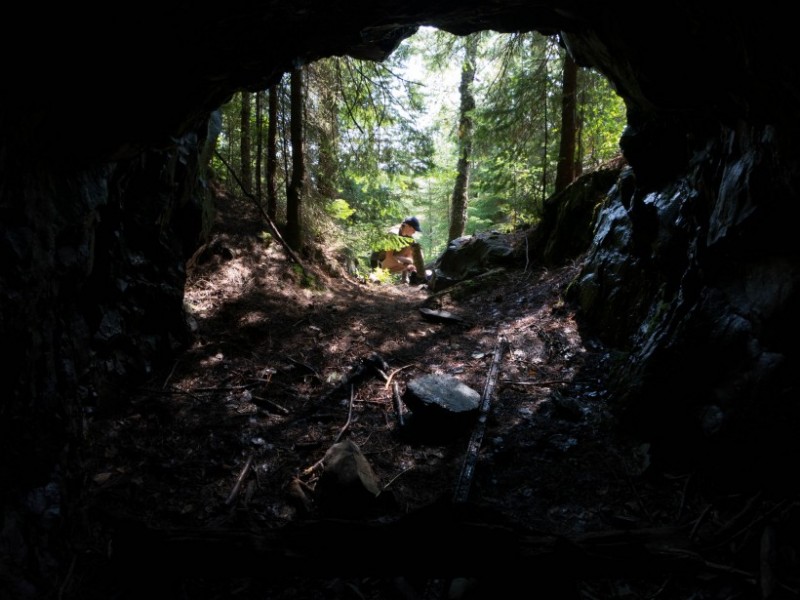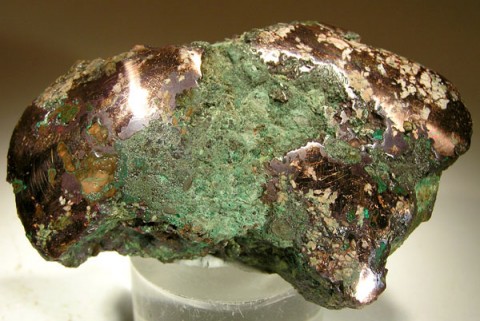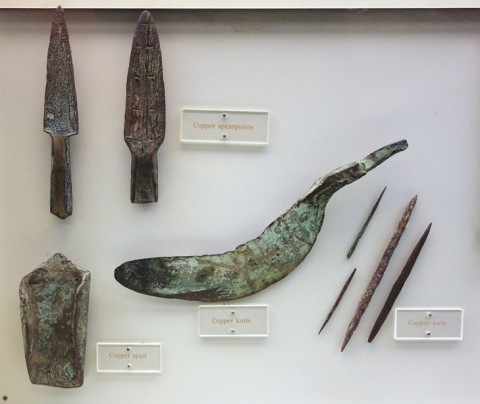Interesting historical account of ancient mining on IR from eos.org by Julia Rosen

Scientists find evidence of ancient copper mining in polluted lake sediments from Isle Royale National Park.
A visitor crouches in front of a shaft entrance at Minong Mine, located in Michigan’s Isle Royale National Park. The site contains remnants of a 19th century copper mine as well as evidence of prehistoric mining activity. Photo by wallofinsanity (CC BY NC-SA 2.0).
By Julia Rosen 24 December 2014
Moose, wolves, and a few intrepid humans roam the wilds of Michigan’s Isle Royale National Park today, but thousands of years ago, the island boasted a thriving mining industry.

A glacially rounded copper nugget, as an example of the raw material worked by people of the Old Copper Complex. Photo by Rob Lavinsky (CC BY-SA 3.0).
The veins of copper that ripple through its bedrock drew the attention of early Native Americans, who used the metal to make tools. However, many details of their activities—such as when they mined—remain hidden behind the thick haze of time.
Now, new research suggests that Isle Royale’s mining boom peaked about 6000 years ago and left a legacy of aquatic pollution. The high levels of copper, lead, and potassium in sediments from a cove on the island point to a long and intense period of indigenous mining. Researchers presented these results, published recently in the journal The Holocene, in a poster session on 16 December at the 2014 American Geophysical Union Fall Meeting.
Evidence of Ancient Mining
European explorers first noticed evidence for indigenous copper mines back in the 1800s. In some places, miners had dug down more than 20 meters into bedrock—an impressive feat considering their limited tools. However, without a way to date the pits directly, the timing of these mining activities could only be loosely constrained by the ages of copper artifacts found across the Great Lakes region. Archaeologists have dated many objects associated with the so-called Old Copper Complex, but the objects span thousands of years.

Copper artifacts created by people of the Old Copper Complex.
The mines caught the interest of David Pompeani, a Ph.D. student at the University of Pittsburgh, who went looking for clues beneath the chilly waters of Lake Superior. He hypothesized that chemicals released during the process of mining and annealing copper would leak into the lake and settle in its sediments. These sediments could then be dated using carbon-14 and other radioactive isotopes.
One such indicator of mining activity is lead, which would have leached from mine tailings and vaporized when miners heated copper to shape the metal, only to collect again in nearby waters. Pompeani and his colleagues previously found lead pollution in 8000- to 5000-year-old sediments along the south shore of Lake Superior. They interpreted this pollution as evidence of an extended era of widespread copper mining on Michigan’s Keweenaw Peninsula.
A Focus on Isle Royale
Several questions followed. How far did these ancient miners range? Did they migrate from one mine to another? To learn more, Pompeani’s team jumped across the lake to Isle Royale, a streak of rock that lies just off the Canadian shore. There, indigenous miners excavated the largest known pre-Columbian copper mine on top of Minong Ridge.
In nearby McCargoe Cove, a deep inlet that cuts diagonally across the island’s glacial striations, the researchers found elevated levels of lead and copper, along with potassium—a by-product of the fires used for mining and annealing. At their peak, lead and copper concentrations reached values an order of magnitude greater than background levels and about half as high as those associated with modern contamination.
The Fate of Ancient Miners
The spike in pollution began 6500 years ago and lasted for about a millennium. Then, abruptly, it ended, suggesting mining ended too. Pollution did not rise again until the mid-1800s, when mining resumed on Isle Royale, smelting began on the Keweenaw Peninsula, and leaded gasoline emissions grew.
The scientists do not know why mining screeched to a halt. They speculate that miners may have exhausted all the easily accessible veins and moved on. Climate changes may have also played a role—evidence from lake sediments around the Midwest suggests climate began to get dryer. In time, geologic clues may continue to provide more information.
—Julia Rosen, Writer
